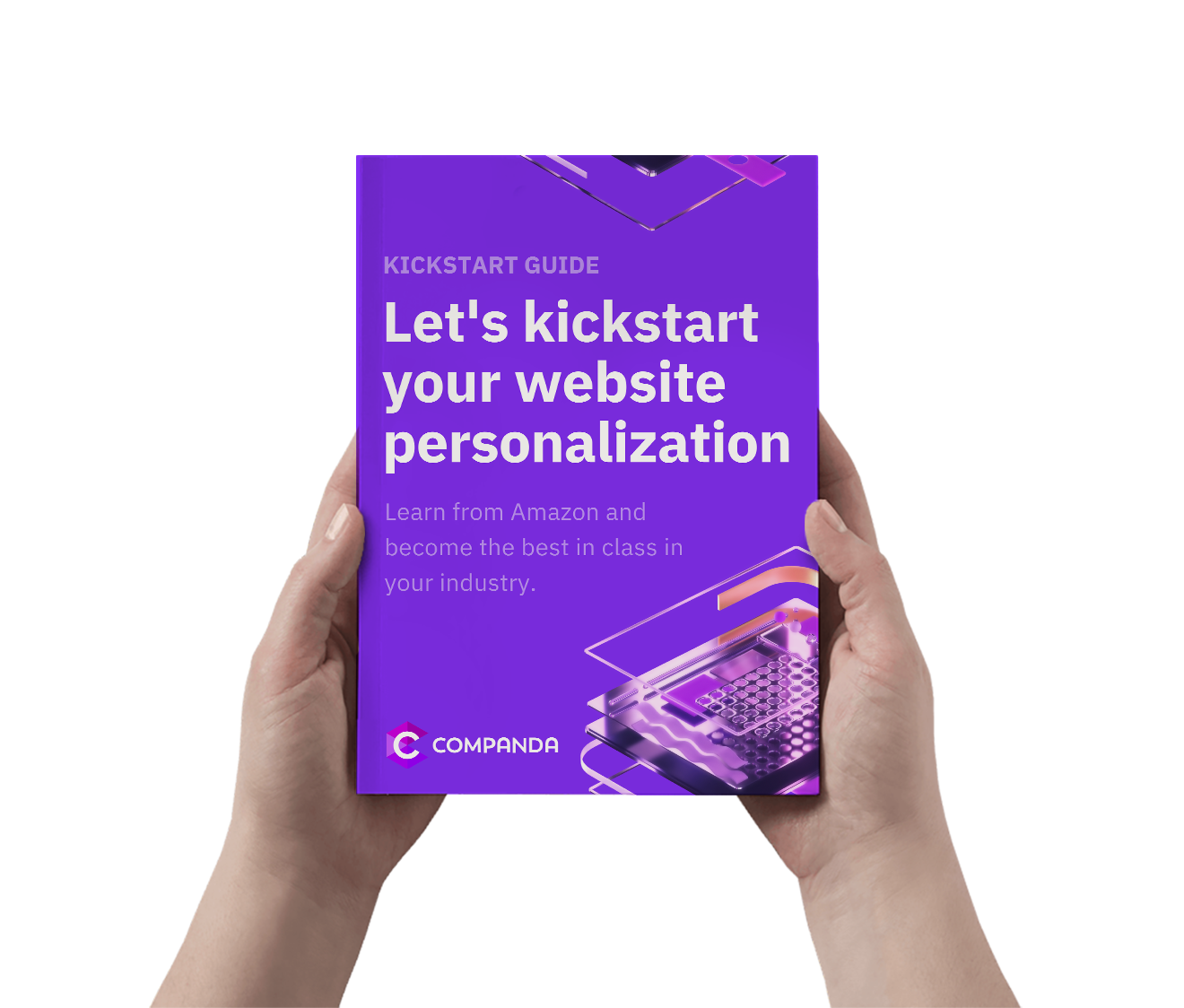Free Download
The Kickstart Guide to Website Personalization
A Practical Guide to Master Website Personalization Quickly

What will you learn
from this book?
This ebook will help you enhance your personalization tactics to boost conversions and improve your customer's experience.
-
1
Success factors
Learn from Amazon and become the best in class in your industry.
-
2
Action plan
Discover how to master website personalization in 4 easy steps.
-
4
Use cases
Get website personalization examples that boost conversions
-
3
Tools
Learn how to use personalization software such as Google Optimize
What's inside
In this ebook you will find use cases, tools and a step by step action plan on how to start with website personalization.

In 1998 Jeff Bezos had a vision for the internet. At that time Amazon existed for four years and was quickly becoming a giant online book and music empire.
4.5 million stores
In that year, Bezos said in an interview with the Washington Post: “If we have 4.5 million customers, we should not have one store but 4.5 million stores.” In other words, Bezos wanted the Amazon homepage to focus on the attraction of each individual visitor. Meanwhile more and more marketers realize that it’s important to have a dynamic, interactive website. The same marketers still find it difficult to ensure that their homepage meets the needs of the most important visitors. Real-time personalization is the key to success here. It ensures that a website attracts the attention of different visitors. In this whitepaper we explain how you can get started with B2B website personalization.
Why to personalize your website
Personalization has proven itself as a powerful tool to improve the conversion of your website. For example, a simple type of personalization is personalizing an email in which you start with the first name of the recipient. It’s a slightly bigger challenge to get started with advanced personalization to make sure you get the attention of the right person at the right moment.
Obstacles and opportunities
In a study done by Gartner, 46% of B2B customers indicate that custom offers are extremely important. Data from Econsultancy shows that there are obstacles for improving personalization. For example, 47% of companies indicate that there are IT obstacles. Nevertheless, Gartner expects a profits increase of up to 15 percent for companies that apply personalization technologies in the right way by 2020. In addition, personalization offers advantages such as more interaction (engagement) with the target audience, more and better conversions, more efficient communication and higher loyalty.
Preview Chapter 2. The early days of website personalization
Many marketers see the personalization of their website as a big challenge. Where do you start and how do you make sure that you deliver specific content for the right audience?
1. Measure your baseline
With the help of this step-by-step guide you can start personalizing your website. Start with assessing the current situation of your website by answering these questions:
Are the right people visiting your website?
Do visitors find what they are looking for?
Do visitors find the content you want to show them?
Some of these questions can be answered through analytics tools such as Google Analytics and Google Search Console. For example, you can find out about which channels are the main source of visitors for your website, which pages they visit and how long they stay on your site. The next step is to divide this data into different categories.
2. Segment your visitors
By segmenting your visitors you can get a clear overview of the value of your visitors. Research from Demandbase shows that 82% of the visitors on B2B websites are not potential customers. It’s therefore important to reach that 1
There are three different types of data in which your visitors can be categorized:
Context: when did the visitor visit your website and through which device.
Company information: think about industry, company size and more.
Behavior: which pages did the visitor visit and how often.
Contextual data helps you to understand what the best approach is for potential customers. Someone who visits your website in the evening may have other intentions compared to a visitor who visits your website during the day. In addition, the focus of people is different during the week than during the weekend.
Thanks to company information, you can further personalize your information. If you are able to find out which companies visit your website, you can appeal to highly targeted companies or even those who work at these companies through Account Based Marketing.
End of preview
This concludes the preview of the ebook. In this ebook you will find use cases, tools and a step by step action plan on how to start with website personalization. So what are you waiting for? Go ahead and download this free ebook now. We only ask your email address in return. Let it elevate your website personalization strategy!
Chapter 1. The early days of website personalization
Chapter 2. How personalize your website in 4 steps
Chapter 3. Examples of website personalization
Chapter 3. Take personalization to the next level
How to use data for advanced personalization that impacts the bottom line.
Chapter 4. Personalization software
Squeeze the most out of your marketing budget.
Chapter 5. Using Google Optimize for personalization
More revenue with the same media spend.
Chapter 6. About Companda
Curious about the content?
Get access to a free sample above.
Frequently Asked Questions (FAQs)
A list that will help you answer some of the more common questions regarding this ebook
Why do I need to fill out information in order download the ebook?
We will always keep your personal information safe.
We ask for your information in exchange for a valuable resource in order to (a) improve your browsing experience by personalizing the Companda website to your needs; (b) send information to you that we think may be of interest to you by email or other means; (c) send you marketing communications that we think may be of value to you. You can read more about this in our privacy statement.
Is this really free?
Absolutely!
Just sharing some free knowledge that we hope you’ll find useful. Keep us in mind next time you have data and marketing questions!
Get instant access to
the full Ebook
